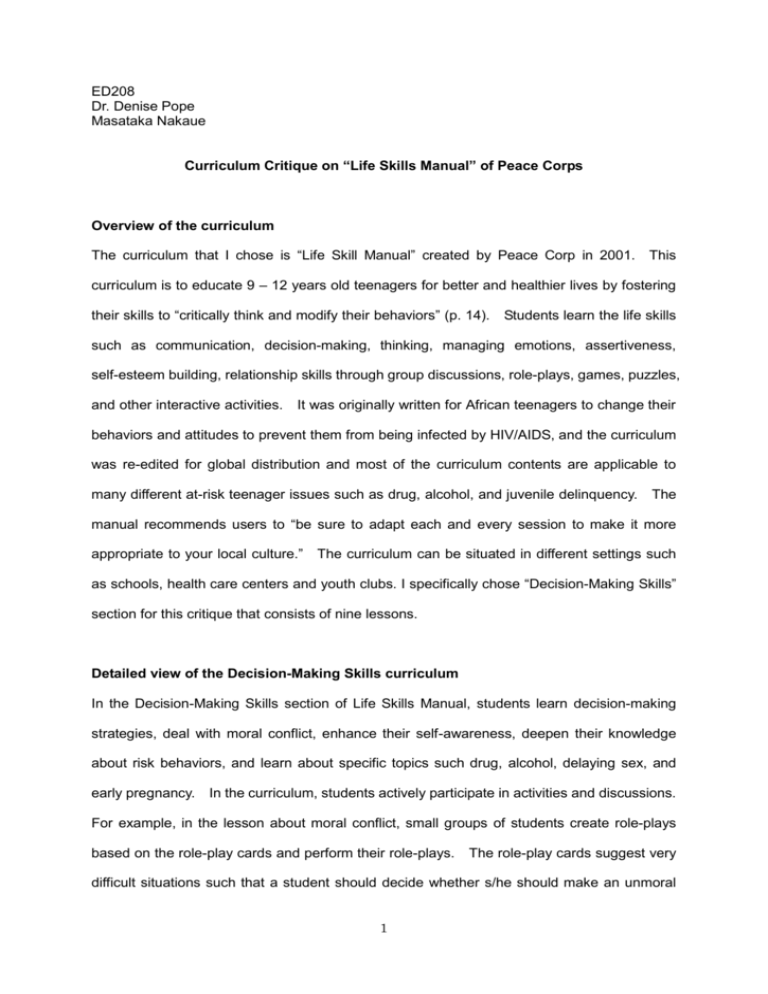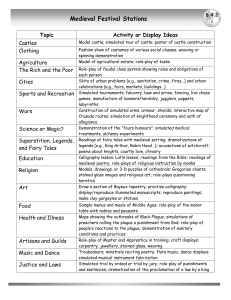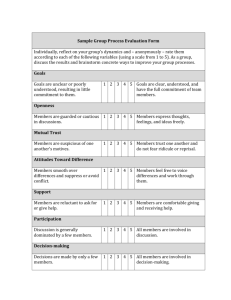Curriculum Critique - Learning, Design and Technology
advertisement

ED208 Dr. Denise Pope Masataka Nakaue Curriculum Critique on “Life Skills Manual” of Peace Corps Overview of the curriculum The curriculum that I chose is “Life Skill Manual” created by Peace Corp in 2001. This curriculum is to educate 9 – 12 years old teenagers for better and healthier lives by fostering their skills to “critically think and modify their behaviors” (p. 14). Students learn the life skills such as communication, decision-making, thinking, managing emotions, assertiveness, self-esteem building, relationship skills through group discussions, role-plays, games, puzzles, and other interactive activities. It was originally written for African teenagers to change their behaviors and attitudes to prevent them from being infected by HIV/AIDS, and the curriculum was re-edited for global distribution and most of the curriculum contents are applicable to many different at-risk teenager issues such as drug, alcohol, and juvenile delinquency. The manual recommends users to “be sure to adapt each and every session to make it more appropriate to your local culture.” The curriculum can be situated in different settings such as schools, health care centers and youth clubs. I specifically chose “Decision-Making Skills” section for this critique that consists of nine lessons. Detailed view of the Decision-Making Skills curriculum In the Decision-Making Skills section of Life Skills Manual, students learn decision-making strategies, deal with moral conflict, enhance their self-awareness, deepen their knowledge about risk behaviors, and learn about specific topics such drug, alcohol, delaying sex, and early pregnancy. In the curriculum, students actively participate in activities and discussions. For example, in the lesson about moral conflict, small groups of students create role-plays based on the role-play cards and perform their role-plays. The role-play cards suggest very difficult situations such that a student should decide whether s/he should make an unmoral 1 behavior public by breaking his/her preceding promise to keep it secret. After each roll play, the entire class will discuss on the following questions: “Do we all agree with the decision that was made?” “Does anyone think the situation should have ended differently?” “What values were at work in arriving at these decisions?” The lesson about “Alcohol and Drug Use” employs role-play, too. “Life Skill Manual” provides some facts about Alcohol and Drug for the instructor, and the instructor leads the introductory discussion about the topic before the role-play to familiarize students with the topic. After the role-play, students think and talk about reasons and consequences of risk behaviors. As in these examples, generally, a lesson starts with an introductory explanation about the topic, and then students do group activities and discussions. Finally, the instructor evaluates the discussions and reinforces positive attitudes and behaviors. Rationales and principles behind the plan “Life Skills Manual” uses a theoretical model named Bridge Model throughout the curriculum for behavioral changes. This model suggests a way to scaffold students to the curriculum’s goal that they feel capable of performing healthier behaviors. In this model, students should cross over the sea of negative consequences from their current troublesome standing points to the land of happier and healthier lives. A bridge is a metaphor of scaffolding. At first, accurate information is provided as a solid foundation. Then, in order to cross the sea of the negative consequences to reach the positive, healthy and fulfilling life, the Life Skills Program provides lessons about individual skills as the planks in the bridge. As “relapse is expected in any behavior change,” the curriculum provides the ways to bring people back onto the bridge. This idea of scaffolding derives from constructivism view of learners that they are active subjects who construct knowledge based on their prior experiences. This view corresponds to the concept of cognitive development that Dewey, Vygotsky and Piaget advocated (Eisner, 1994). Students spontaneously cross the bridge with the support from their peers and instructors. This is a different education model from the Banking education that Freire criticized, in which students are mere information consumers. Life Skills Manual 2 recommends; “keep your participants involved by eliciting answers from them rather than lecturing to the group” (p. 19). It also says that “information is, although necessary, is rarely enough by itself to behavior change in most people” (p. 10). The influence of progressivism in Life Skills Manual can also be identified by the method that students learn by solving difficult problems through role-plays, games, and discussions. As to progressivism, Eisner describes it; “First and foremost, it was to be problem-centered.” Students think of the given problematic scenarios and discuss the solutions together. Also, as in Dewey’s progressivism, the processes of Life Skills Manual’s activities are democratic that agreement and critical thinking based on reasoning is emphasized in discussions. For example, in the risk behavior lesson, students are encouraged to “reach an agreement on the levels of risk” when they categorize various risk behaviors to different level of risk (p. 172). Settings and context As described earlier, the curriculum can be localized in many different settings. In any case, it strongly encourages the implementer to work closely with community leaders and peer educators. Community leaders are those who support the program. If the curriculum were implemented in a school, then they would be teachers and headmasters. Peer educators should be carefully considered before the implementation because they can be inappropriate for some students. The educator who uses this curriculum is expected to have excellent communication skills with those who are related to the program. In addition, the educators should understand democratic procedures to create the framework for the students to learn from each other. The teachers are required to have the skills to coordinate of the discussions and activities as well as to bring necessary information to the classes. Analysis of the intended goals and learning activities Decision-making skills are acquired throughout the nine lessons. The sequence of the lessons are organized such that students learn from general topics to more specific topics so that specific topics such as early pregnancy and delaying sex do not overwhelm the students 3 before they have general decision-making skills. This is based on one of the curriculum’s principles: “If fear is overwhelming it can hinder, rather than help efforts to change. Too much fear may cause people to deny they are at risk … and to avoid seeking medical care altogether” (p.10). The flow of each lesson is; 1) students briefly learn basic information about the topic. 2) Students construct knowledge in small groups by activities such as making scenarios, sorting out different values, and thinking about their own opinions. 3) Finally, the groups share their thoughts with the entire class and evaluate each other’s activities. The activities of Decision-Making Skills manual are designed carefully with the sensitivity to the students’ mental load and that is required for a curriculum that deals with human skills. As to relatively positive and neutral themes such as “The Person I Admire” and “Your Goals,” students will think about the topics on their own experiences, their own thoughts and their own characters. However, when it comes to relatively negative and difficult topics, students perform role-plays, games, and puzzles. In this way, they do not have to directly face their own difficult problems, which they often do not want to, but they can still learn the essential ideas which will eventually help them when they are forced to face their own issues. Assessment Assessment in this curriculum is mainly for the educators, community leaders, and community members. It uses both formative and summative assessments. The assessments are conducted to “raise awareness of key issues” in the community and “pint to any changes that could be implemented to improve the program”(p.17). We can analyze this curriculum’s assessment as its purpose is for accountability to the community and for the educators’ understanding about their students. The curriculum is missing the assessment for students to know how well they understand the topic issues. Thinking of the open-ended characteristics of the curriculum, I suggest that the assessment on students’ performance should be formative, constructed response format such that students keep their portfolios and reflective logs. This will help students be more aware of the emerging learning about their life skills. 4






